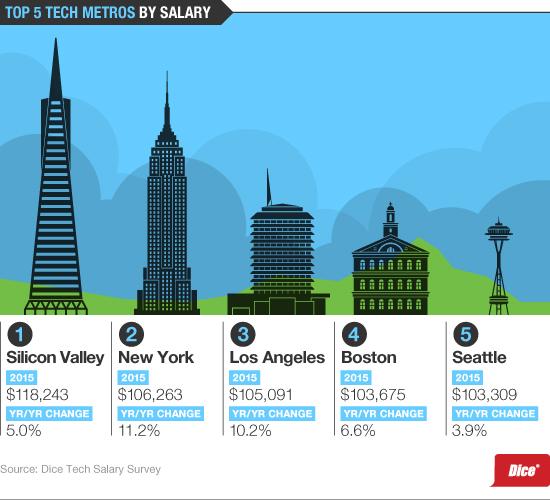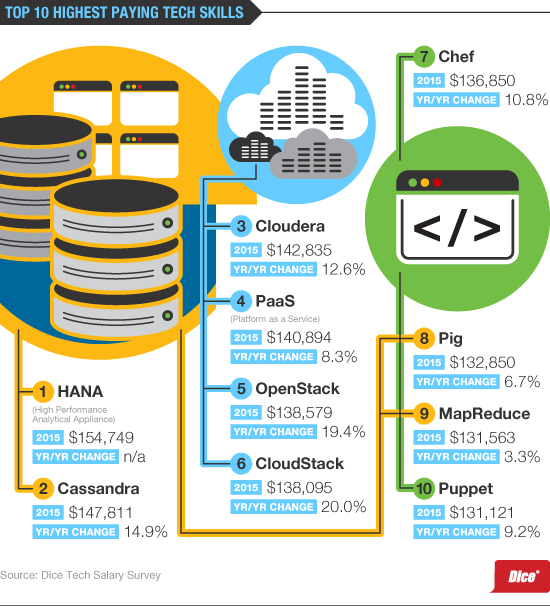
Rising salaries for tech professionals are putting the squeeze on employer budgets when it comes to new hiring, making it more important than ever for recruiters and HR professionals to find tech candidates with the right mix of skills and experience.
Tech salaries rose 7.7 percent between 2014 and 2015, the biggest year-over-year increase in the history of Dice’s Salary Survey. As ranked by salary, the most popular tech skills included enterprise applications, programming, databases, operating systems, and cloud/virtualization. Specialists in the following skills could expect especially generous payouts:

Despite rising salaries and bonuses, however, a full third of tech professionals (32 percent) told Dice they weren’t happy with their current pay, up slightly from 31.6 percent in 2014. That’s despite 62 percent of professionals reporting a salary increase from the previous year, and 37 percent receiving a bonus.
Based on responses to the survey, it seems that many employers aren’t offering flexibility, interesting assignments, or training as a primary means of retaining their best and brightest. Around 33 percent of respondents said their workplace had given them no “primary motivator” in 2015. Although 17 percent of employers provided increased compensation as a way of keeping their employees happy, far fewer resorted to flexible work hours (9 percent), the option to telecommute or head to a flexible work location (13 percent), interesting or challenging assignments (12 percent) or training and certification courses (3 percent).
Despite the lack of motivators, previous Dice surveys and reports have demonstrated that an emphasis on work-life balance (and perks) is just as effective as salary when it comes to keeping tech professionals engaged.
For employers, there are several takeaways from this year’s salary data. First, experienced tech professionals with specialized skill-sets can demand even higher salaries, which can make things more complex when it comes to attempting to hire the very best talent. While salaries in some regions and industries experienced minor decreases between 2014-15, there was a strong upward trend in salaries across the country as a whole. Expect that trend to continue into 2016.
Shape the Narrative
So how does an employer actually pull in the best talent? Let’s picture for a moment that you’re the head of a medium-sized tech company, one that produces apps for Apple’s iOS and Google Android. Your competitive landscape is aggressive, with rival firms constantly threatening to release more feature-rich products. The difference between success and failure rests on your recruiting staff’s ability to draw in mobile developers, data analysts, and other technology professionals who can not only iterate on your existing products, but also discover new market opportunities.
In a major tech hub such as San Francisco or New York City, or even an up-and-coming city such as Raleigh, there’s a lot of talent present, although high costs of salaries and low unemployment might make them hard to secure. Rising salaries mean that even tech professionals with a smaller portfolio of skills have more good opportunities to choose from. As a recruiter, the best way to differentiate yourself is to emphasize your firm’s willingness to let employees telecommute or work “non-traditional” hours, or help with education costs related to new skills and certifications—basically, any benefits that don’t necessarily fall under the rubric of “salary.”
As major firms such as Google have demonstrated over the years, onsite perks such as cafeterias, gyms, dry cleaning, and “pet friendly” offices can also play a significant role in attracting the talent you need. There’s just one challenge when offering up such quality-of-life benefits: other companies, from the giants down to the startups, have similar benefits already on-tap.
Because of that competition, successfully hiring the best tech talent means spinning a cohesive tale of why working for your company will improve their lives and careers, as opposed to simply offering them a list of potential benefits. No matter what the job or geographic area, tech candidates will respond to a narrative that positions your company as the best thing for their careers at this moment.


